We have over the years read of paintings by chimpanzees, but
could they be art critics also?
A recent article has appeared, outlining
evidence that many cognitive tasks the we take to be a function of our human
intelligence can be performed just as well (or even better) by chimpanzees. Here are links to two versions of the
article:
|
|
|
Both versions ask the question “could a chimpanzee
distinguish a Picasso from a Monet?”
Apparently, they ought to be able to, since
both honeybees and pigeons have been trained to do it. Scientists taught these small-brained species that chambers next to pictures by one or other of these artists contained food. When later presented with new Picassos and Monets, they were more likely to opt for the artist whose work had previously led them to a reward – meaning they had picked up on underlying stylistic differences. Many skills that we consider complex are in fact the result of relatively simple – and often universal – cognitive abilities shared by a great many species.
But this is a
useful basis for asking you all an artistic question. The BBC (aka “Auntie”) has
been giving us some programmes on the development of abstract art. Most of the original abstract artists were
European, but they based their theories on the ideas of Helena Petrovna Blavatsky, philosopher and occultist,
originally Russian but largely based in New York.
One of her most
prominent disciplines was Wassily Wassilyevich
Kandinsky, perhaps the most important foundational figure of the
abstract art movement. Below is one of
his most famous works, Picture with a
black arch. Abstract art is supposed to be non-representational, but this shouts
something at me.
Does it, gentle reader, suggest anything to
you?





Comments